Off-grid air heating offers sustainable, DIY solutions for your home's heating needs. You can explore options like solar air heaters, wood-burning stoves, and geothermal heat pumps to reduce energy costs and your carbon footprint. These systems can be tailored to your local climate and available resources, providing energy independence. Solar air heating, for instance, can cut heating costs by 25-50% with a 20-30 year lifespan. By combining proper insulation, thermal mass materials, and passive solar design, you'll maximize heat retention and distribution. With the right approach, you can create an efficient, eco-friendly heating system that suits your specific needs and budget.
Understanding Off-Grid Air Heating

How can you keep your home warm without relying on traditional power sources? Off-grid air heating offers sustainable solutions for homeowners seeking independence from conventional energy systems. This approach utilizes alternative methods to generate heat, often harnessing renewable resources.
To understand off-grid air heating, you'll need to familiarize yourself with various technologies. Solar air heaters capture the sun's energy to warm air, which is then circulated throughout your home.
Wood-burning stoves and masonry heaters provide efficient, long-lasting heat by burning renewable biomass. Geothermal heat pumps tap into the earth's constant temperature to regulate indoor climate.
You'll also need to take into account your home's insulation and thermal mass. Proper insulation reduces heat loss, while thermal mass materials like concrete or stone absorb and slowly release heat.
Passive solar design principles can maximize natural heat gain through strategic window placement and building orientation.
Off-grid air heating systems often require a combination of methods to guarantee consistent warmth. You'll need to evaluate your local climate, available resources, and energy needs to determine the most effective solution for your home.
Benefits of Solar Air Heating
Solar air heating offers significant benefits for your home's sustainability.
You'll experience substantial energy cost savings as you harness free solar power to warm your living spaces.
Energy Cost Savings
Typically, homeowners can expect considerable energy cost savings when implementing solar air heating systems. You'll notice a substantial reduction in your heating bills, especially during winter months when energy consumption is highest. These systems can offset up to 25-50% of your home's heating costs, depending on factors like your location, system size, and energy usage patterns.
You'll also benefit from long-term savings as solar air heaters have minimal maintenance requirements and a lifespan of 20-30 years. Unlike traditional heating systems, you won't need to worry about fluctuating fuel prices or rising electricity costs. The sun's energy is free, allowing you to lock in your heating expenses for decades.
Additionally, you may qualify for federal, state, or local incentives that can further reduce your initial investment. These can include tax credits, rebates, or grants specifically designed to encourage renewable energy adoption.
Environmental Impact Reduction
Considering the environmental benefits, solar air heating systems offer a significant reduction in your carbon footprint. By harnessing the sun's energy, you're using a clean, renewable resource that doesn't emit greenhouse gases or other pollutants. This change away from fossil fuels helps combat climate change and reduces air pollution in your local area.
You'll also be conserving natural resources. Solar air heating doesn't require the extraction, processing, or transportation of fuel, which preserves ecosystems and reduces habitat destruction. The systems have a long lifespan and require minimal maintenance, further reducing their environmental impact over time.
Installing a solar air heater can inspire others in your community to adopt sustainable practices. As you showcase the effectiveness of this eco-friendly technology, you'll contribute to a broader shift towards renewable energy. Additionally, by reducing your reliance on the power grid, you're indirectly supporting the movement to cleaner energy infrastructure.
The materials used in solar air heaters are often recyclable, and their production has a lower environmental impact compared to traditional heating systems. This choice supports a more circular economy and reduces waste in the long run.
Types of Solar Collectors
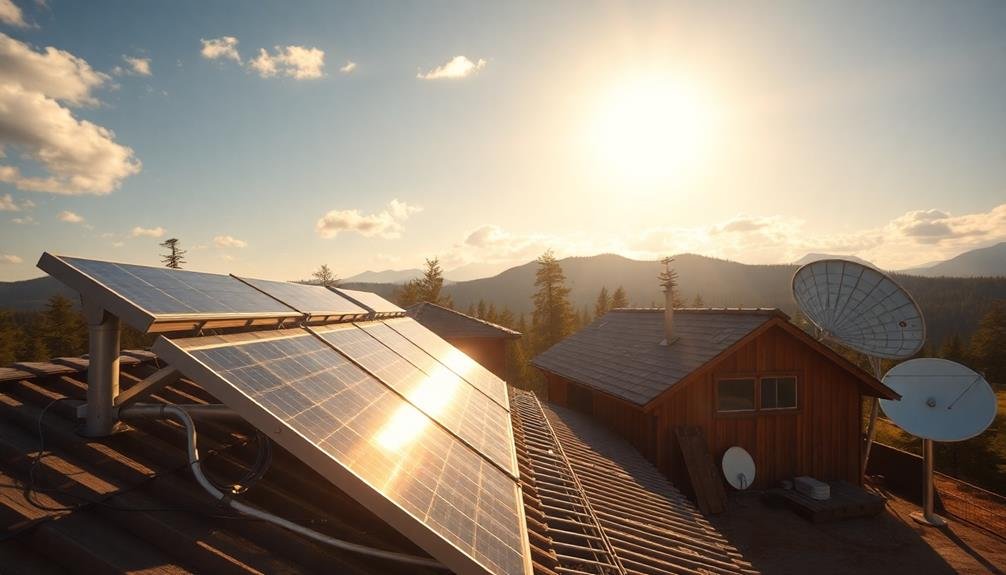
When it comes to harnessing the sun's energy for home heating, you'll find various types of solar collectors available. The most common types are flat-plate collectors, evacuated tube collectors, and concentrating collectors. Each has its own advantages and is suited for different applications.
Flat-plate collectors are the simplest and most widely used. They consist of a dark, flat surface that absorbs sunlight and transfers the heat to a fluid circulating through pipes. These collectors are cost-effective and work well in moderate climates.
Evacuated tube collectors are more efficient, especially in colder regions. They're made up of parallel rows of glass tubes, each containing an absorber plate. The vacuum inside the tubes reduces heat loss, making them effective even in low sunlight conditions.
Concentrating collectors use mirrors or lenses to focus sunlight onto a smaller area, generating higher temperatures. They're typically used for larger-scale applications or in areas with intense sunlight.
When choosing a solar collector for your DIY heating project, consider:
- Your local climate and sunlight conditions
- The required temperature for your heating system
- Available space and budget constraints
Designing Your DIY System
When designing your DIY home heating system, you'll need to start by evaluating your heating requirements.
Next, you'll choose an appropriate energy source based on your needs and local resources.
Assess Heating Requirements
The first step in designing your DIY sustainable heating system is to accurately evaluate your home's heating requirements. You'll need to take into account factors such as your local climate, the size of your living space, and your home's insulation quality.
Start by calculating your home's heat loss rate, which will help determine the amount of heat needed to maintain a comfortable temperature.
To evaluate your heating requirements effectively:
- Measure your home's square footage and ceiling height
- Identify areas of heat loss, such as windows, doors, and poorly insulated walls
- Reflect on your desired indoor temperature and the average outdoor temperature during winter months
Next, use an online heat loss calculator or consult with a professional to determine your home's heat loss in BTUs (British Thermal Units) per hour. This figure will guide you in selecting appropriately sized heating components for your DIY system.
Don't forget to account for future improvements in insulation or changes to your living space that might affect your heating needs.
Choose Energy Source
Your home's sustainable heating system hinges on choosing the right energy source. Consider several options based on your location, budget, and environmental goals.
Solar thermal systems can harness the sun's energy to heat water or air, making them ideal for sunny climates. Biomass boilers use renewable wood pellets or chips, perfect if you have access to sustainable forestry resources. Geothermal heat pumps tap into the earth's constant temperature, offering efficient heating in various climates but require significant upfront investment.
For those in windy areas, small-scale wind turbines can generate electricity for heating. Air-source heat pumps work well in moderate climates, extracting heat from outside air. If you're near moving water, micro-hydro systems can provide consistent power.
Consider combining multiple sources for a more reliable system. Each option has pros and cons, so weigh factors like initial costs, maintenance requirements, and long-term efficiency.
Don't forget to check local regulations and available incentives for renewable energy installations. Your choice should align with your property's characteristics and your personal sustainability goals, ensuring a heating solution that's both eco-friendly and cost-effective in the long run.
Plan Component Layout
Now that you've selected your energy source, it's time to map out your DIY heating system's components. Begin by sketching a floor plan of your home, marking the areas you want to heat. Consider the layout of your energy source, whether it's solar panels on the roof or a biomass furnace in the basement.
Next, plan the placement of your heat distribution system. If you're using forced air, map out the ductwork routes. For radiant floor heating, outline the areas where you'll install tubing. Don't forget to include space for important components like heat exchangers, pumps, and control systems.
When planning your component layout, keep these essential factors in mind:
- Efficiency: Minimize heat loss by keeping pipe runs short and insulating thoroughly.
- Accessibility: Guarantee easy access to components for maintenance and repairs.
- Safety: Follow local building codes and maintain proper clearances around heat-generating equipment.
Consider zoning your system to heat different areas independently, improving both comfort and energy efficiency.
Essential Materials and Tools

What tools and materials do you need to create sustainable DIY home heating solutions?
For most projects, you'll require basic hand tools like hammers, screwdrivers, pliers, and measuring tape. Power tools such as drills, saws, and sanders will speed up your work. Don't forget safety equipment: goggles, gloves, and dust masks.
For materials, consider heat-absorbing elements like dark-colored tiles, bricks, or stones. Insulation is vital; options include fiberglass, cellulose, or natural materials like wool or cotton. You'll need wood for framing and potentially for fuel in wood-burning systems.
Metal components like pipes, ducts, and heat exchangers are essential for many heating solutions.
If you're building a solar air heater, you'll need clear polycarbonate sheets, aluminum flashing, and black paint. For a rocket mass heater, gather fire bricks, metal ducting, and cob mixture ingredients.
Geothermal systems require PEX tubing and a heat pump. Don't overlook fasteners, sealants, and weatherstripping to guarantee your system's efficiency.
Building a Solar Air Heater
You'll need specific materials and tools to construct your own solar air heater, including plywood, polycarbonate sheets, and a drill.
The step-by-step construction process involves building the frame, installing the absorber plate, and adding the glazing to capture solar heat.
To maximize efficiency and performance, you'll want to position your heater for ideal sun exposure and guarantee proper insulation throughout the system.
Materials and Tools Needed
Building a solar air heater requires a handful of essential materials and tools.
You'll need a wooden frame, typically made from 2×4 lumber, to house your heater. For the collector surface, opt for a sheet of corrugated metal roofing or aluminum flashing, painted black to maximize heat absorption. You'll also need a clear polycarbonate sheet or tempered glass to create a greenhouse effect.
For insulation, use rigid foam board or fiberglass batts to line the interior of the frame. Don't forget to include an inlet and outlet for air circulation, along with ductwork to connect your heater to your home.
As for tools, you'll need:
- A circular saw or hand saw for cutting lumber
- A drill with various bits for assembly and mounting
- A caulking gun for sealing joints and edges
Additional items include screws, weatherstripping, and paint. You might also want a thermometer to monitor the heater's performance.
With these materials and tools in hand, you're ready to start constructing your solar air heater, taking a significant step towards sustainable, off-grid heating for your home.
Step-by-Step Construction Process
The solar air heater's construction begins with building the frame. Cut the wooden boards to size and assemble them using screws or nails. Next, attach the plywood backing to create a sturdy base. Paint the interior black to maximize heat absorption.
Install the insulation layer, followed by the corrugated metal sheet. Secure these layers with adhesive and screws. Drill inlet and outlet holes at the bottom and top of the frame, respectively. Attach the glazing material (typically polycarbonate or glass) to the front, ensuring an airtight seal.
Here's a quick guide to the construction layers:
| Layer | Material | Function | Installation Tips |
|---|---|---|---|
| 1 | Plywood | Base | Secure tightly to frame |
| 2 | Insulation | Heat retention | Fill gaps completely |
| 3 | Metal sheet | Heat absorption | Paint black for efficiency |
| 4 | Glazing | Solar collection | Seal edges thoroughly |
Efficiency and Performance Tips
To maximize the efficiency of your solar air heater, proper positioning and maintenance are essential. Install your heater on a south-facing wall or roof to capture the most sunlight throughout the day. Make sure it's angled at your latitude plus 15 degrees for ideal year-round performance.
Keep the collector surface clean and free from debris to maintain peak efficiency. Insulate the back and sides of your heater to minimize heat loss. Use high-quality, heat-resistant materials for the absorber plate and glazing to improve heat retention and transfer.
Consider adding a small fan to increase air circulation and heat distribution throughout your space. Monitor your heater's performance regularly and make adjustments as needed.
To enhance your solar air heater's efficiency:
- Seal any air leaks in your home to prevent heat loss
- Use reflective materials around the heater to concentrate sunlight
- Implement a thermal mass system to store excess heat for nighttime use
Installation and Positioning Tips

Proper placement and installation are essential for maximizing the efficiency of your DIY home heating solutions. When positioning your heating system, take into account the layout of your space and thermal dynamics.
Place heat sources on the coldest walls, typically exterior-facing ones, to counteract heat loss. For radiant floor heating, guarantee even distribution of heating elements throughout the room.
Install insulation before your heating system to prevent heat escape and improve overall efficiency. Use weatherstripping and caulk to seal any gaps or cracks around windows and doors.
If you're installing a wood stove, follow local building codes for proper clearances and ventilation requirements.
For solar air heaters, mount panels on south-facing walls or roofs to capture maximum sunlight. Angle them at your latitude plus 15 degrees for peak winter performance.
When installing geothermal systems, work with a professional to determine the best location for ground loops based on soil conditions and available space.
Remember to take into account accessibility for maintenance when positioning your heating system. Keep air intakes clear of obstructions and guarantee proper airflow around heating units.
Maximizing Heat Distribution
Optimizing heat distribution throughout your home is essential for maintaining comfort and efficiency in your DIY heating system. To maximize heat flow, start by ensuring proper insulation in your walls, floors, and ceilings. This will prevent heat loss and allow your system to work more effectively.
Next, consider the layout of your space and strategically place heat sources in areas where they'll have the most impact. You can improve heat circulation by using ceiling fans in reverse mode, which pushes warm air down from the ceiling. Additionally, keep interior doors open to allow heat to move freely between rooms.
For multi-story homes, install vents or grilles in the floor to let warm air rise naturally to upper levels.
To further enhance heat distribution, consider these strategies:
- Use reflective panels behind radiators to direct heat into the room
- Install thermal curtains to prevent heat loss through windows
- Place furniture away from heat sources to avoid blocking airflow
Remember to regularly maintain your heating system, including cleaning or replacing filters and ensuring all components are functioning properly.
Maintenance and Troubleshooting

Regular maintenance and troubleshooting are essential for keeping your DIY home heating system running smoothly and efficiently. You'll need to perform routine checks and address common issues to guarantee peak performance. Start by inspecting your system monthly, looking for signs of wear, leaks, or blockages.
Clean or replace filters regularly, as clogged filters reduce airflow and efficiency. Check and clean vents, ducts, and radiators to maintain proper heat distribution. For wood-burning stoves, remove ash and creosote buildup to prevent fires and improve heat output.
Here's a quick guide to common issues and their solutions:
| Problem | Possible Cause | Solution |
|---|---|---|
| Uneven heating | Blocked vents | Clear obstructions |
| Strange noises | Loose components | Tighten or replace parts |
| Poor efficiency | Dirty filters | Clean or replace filters |
| System won't start | Thermostat issues | Check batteries, recalibrate |
If you encounter persistent problems, consult a professional. Remember to prioritize safety when working on your heating system. Always turn off the power before attempting repairs, and don't hesitate to seek expert help for complex issues.
Integrating With Existing Systems
When implementing sustainable DIY home heating solutions, you'll often find yourself working with pre-existing systems. It's essential to understand how your new eco-friendly heating methods can seamlessly integrate with your home's current setup.
Start by evaluating your existing heating infrastructure, including ductwork, radiators, or radiant floor systems. You'll need to determine if your DIY solution can complement or partially replace these systems.
Consider these key factors when integrating your sustainable heating solution:
- Compatibility: Verify your DIY system works well with existing controls and thermostats.
- Capacity: Calculate if your new solution can meet your home's heating demands alone or in conjunction with current systems.
- Energy efficiency: Analyze how the combined systems will impact your overall energy consumption and costs.
If you're installing a heat pump or solar thermal system, you may need to modify your existing plumbing or electrical systems.
For biomass or geothermal solutions, you might require additional space for equipment or underground installations.
Always consult with a professional to guarantee safe and proper integration, especially when dealing with complex systems or local building codes.
Cost Analysis and Savings
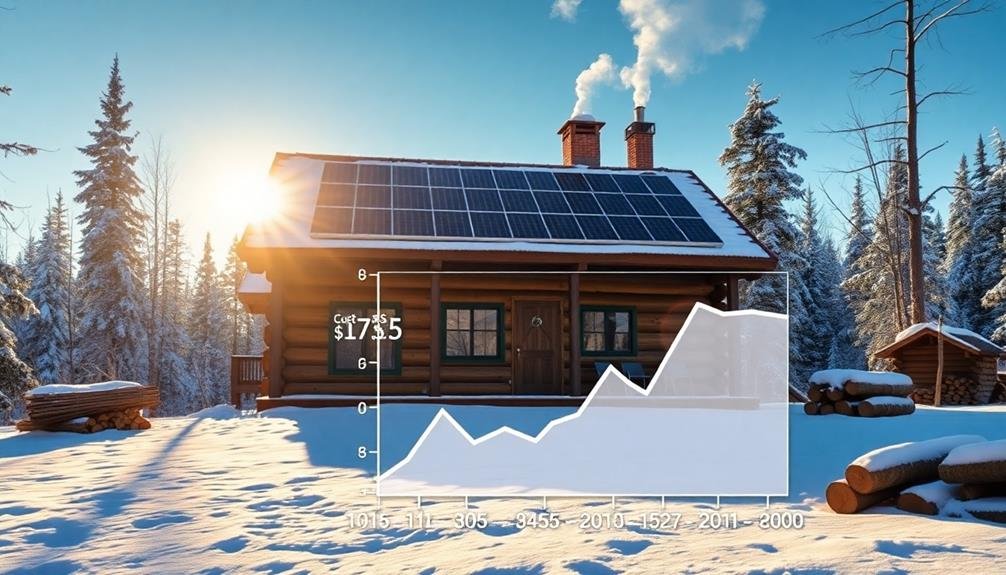
Money talks when it comes to sustainable DIY home heating solutions.
You'll want to evaluate both upfront costs and long-term savings when assessing your options. While initial expenses for materials and installation can be higher than traditional systems, you'll often recoup these costs through reduced energy bills over time.
Solar air heaters, for example, may cost $1,000-$3,000 to install but can save you 30-70% on heating costs annually.
Geothermal systems have higher upfront costs ($10,000-$30,000) but can slash your heating bills by up to 70% and last for decades.
DIY rocket mass heaters can be built for under $500 and provide efficient heating at a fraction of the cost of conventional systems.
Don't forget to factor in potential tax incentives and rebates for renewable energy installations. These can greatly offset your initial investment.
Additionally, evaluate the added value to your home and reduced carbon footprint when calculating overall savings.
Overcoming Climate Challenges
Different climate zones present unique challenges for sustainable DIY home heating solutions. You'll need to adapt your approach based on your specific climate to guarantee efficient and effective heating.
In colder regions, you'll face increased energy demands and potential equipment strain, while humid areas might struggle with moisture control.
To overcome these challenges, consider the following strategies:
- Insulation optimization: Enhance your home's insulation to minimize heat loss, regardless of your climate.
- Climate-specific system selection: Choose heating methods tailored to your region's conditions, such as geothermal for consistent ground temperatures or solar thermal for sunny areas.
- Hybrid solutions: Combine multiple heating technologies to address varied weather patterns and maximize efficiency.
You'll also need to account for extreme weather events in your area. Design your system with redundancy and backup power sources to guarantee heating during storms or outages.
In arid climates, focus on moisture retention to prevent dry air issues. For coastal regions, protect your equipment from salt air corrosion with proper sealing and maintenance.
Future of Off-Grid Heating
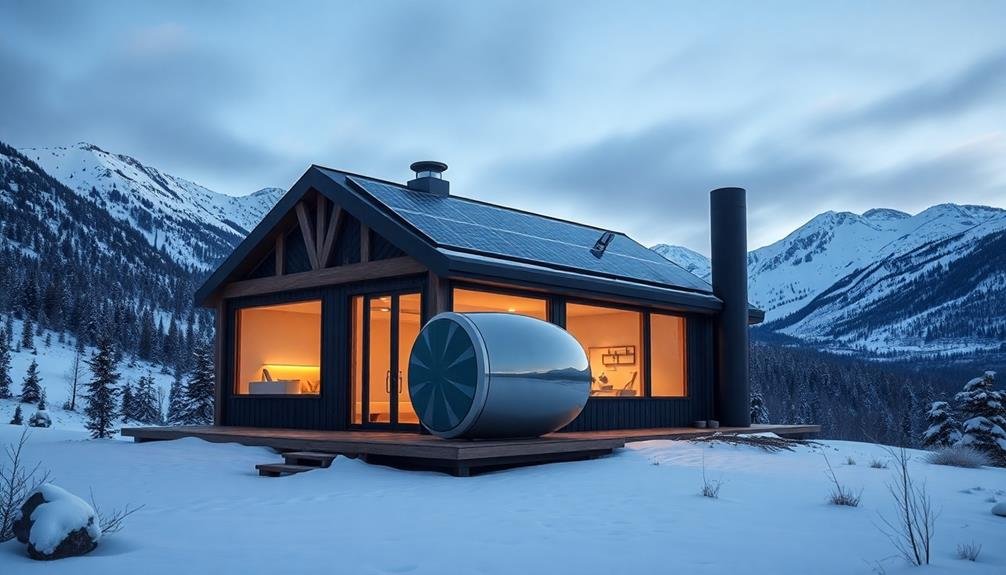
The future of off-grid heating is rapidly evolving, with innovative technologies poised to revolutionize how you heat your home sustainably.
You'll soon see advancements in solar thermal systems that capture and store heat more efficiently, even in colder climates. Expect improvements in phase-change materials that can store and release heat as needed, providing a steady temperature throughout your home.
Artificial intelligence and smart home integration will play a significant role in optimizing your off-grid heating system. These technologies will learn your habits and preferences, adjusting heating patterns for maximum efficiency and comfort.
You'll also witness the rise of micro-CHP (Combined Heat and Power) systems, which generate both electricity and heat from renewable sources like biomass or hydrogen fuel cells.
Geothermal heat pumps will become more accessible and affordable, allowing you to tap into the earth's constant temperature for year-round heating and cooling.
Additionally, you'll see advancements in building materials that provide better insulation and thermal mass, reducing your overall heating needs.
As these technologies progress, you'll find it easier and more cost-effective to heat your home sustainably off the grid.
Frequently Asked Questions
Can Off-Grid Air Heating Systems Work Effectively in High-Humidity Environments?
Yes, off-grid air heating systems can work in high-humidity environments. You'll need to focus on dehumidification alongside heating. Consider using heat pumps or solar thermal systems with moisture-removing features for ideal performance in humid conditions.
Are There Any Health Risks Associated With DIY Solar Air Heating Systems?
You should be aware of potential health risks with DIY solar air heating systems. Improper installation can lead to mold growth, poor air quality, or fire hazards. It's essential you follow safety guidelines and consider professional consultation for best results.
How Do Off-Grid Air Heating Systems Perform During Extended Periods of Overcast Weather?
During extended overcast periods, you'll notice reduced performance in off-grid air heating systems. They'll still work, but won't be as effective. You might need to rely on backup heating methods or increase insulation to maintain comfort.
Can Off-Grid Air Heating Be Combined With Other Renewable Energy Sources?
Yes, you can combine off-grid air heating with other renewable sources. You'll find that integrating solar panels, wind turbines, or geothermal systems enhances your heating efficiency. It's a smart way to diversify your energy supply and increase reliability.
What Permits or Regulations Should I Consider Before Installing an Off-Grid Heating System?
You'll need to check local building codes and zoning laws. Contact your city's planning department for specific permits. Don't forget to take into account environmental regulations, especially if you're using a wood-burning system. Always prioritize safety and compliance.
In Summary
You've now explored the world of off-grid air heating, from understanding its basics to designing your own system. By embracing solar collectors and DIY solutions, you're not just saving money, but also reducing your carbon footprint. As you integrate these sustainable methods with existing systems, you'll overcome climate challenges and contribute to a greener future. Keep innovating and adapting – the future of off-grid heating is bright and in your hands.
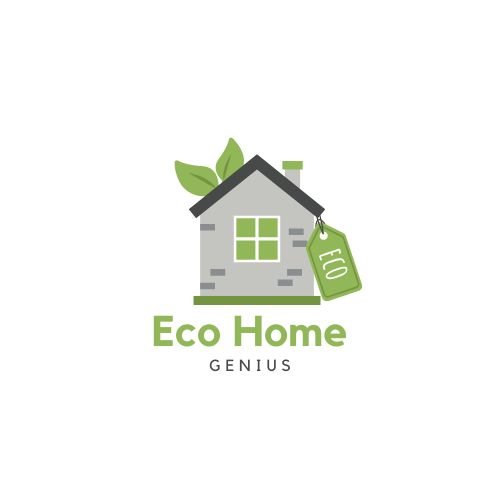
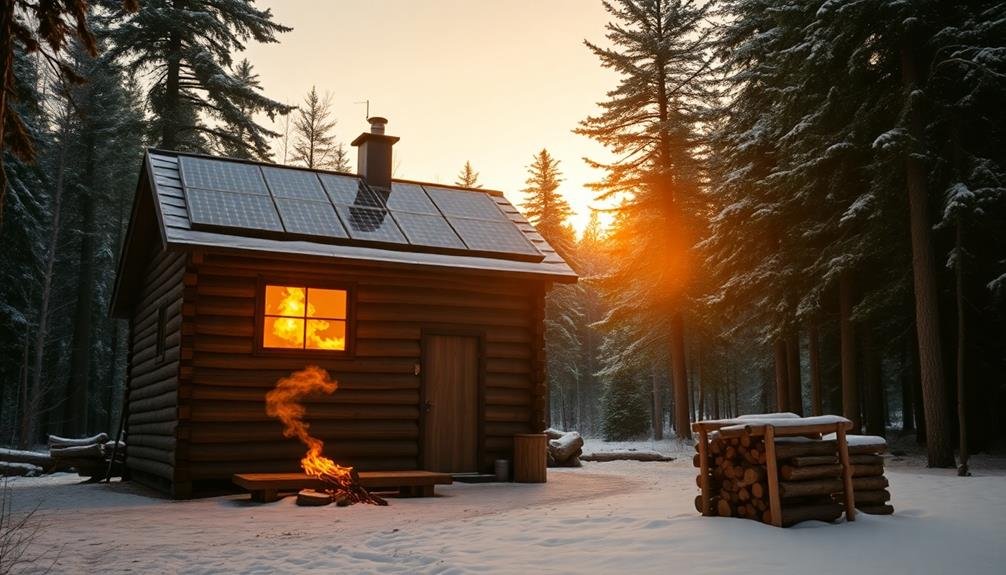
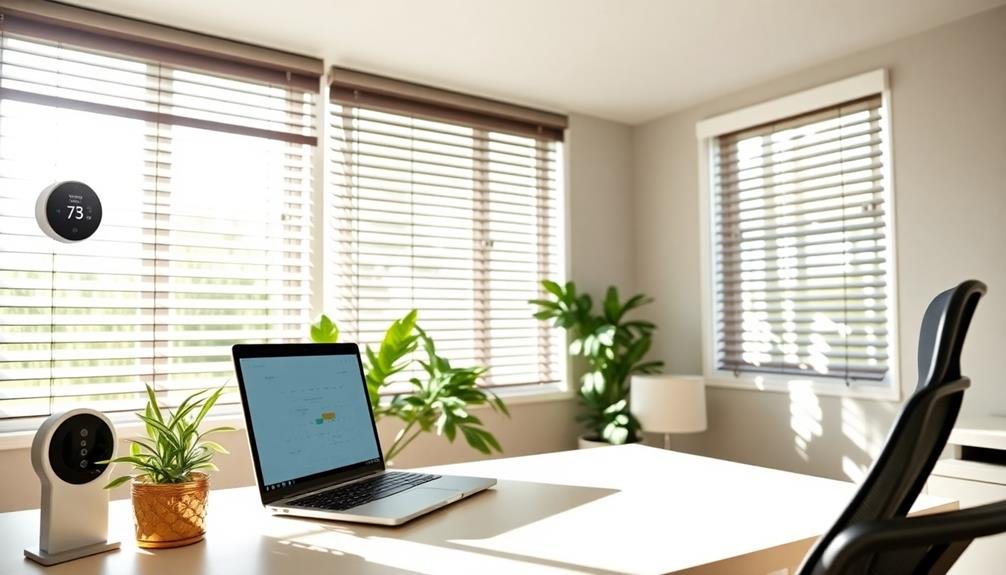
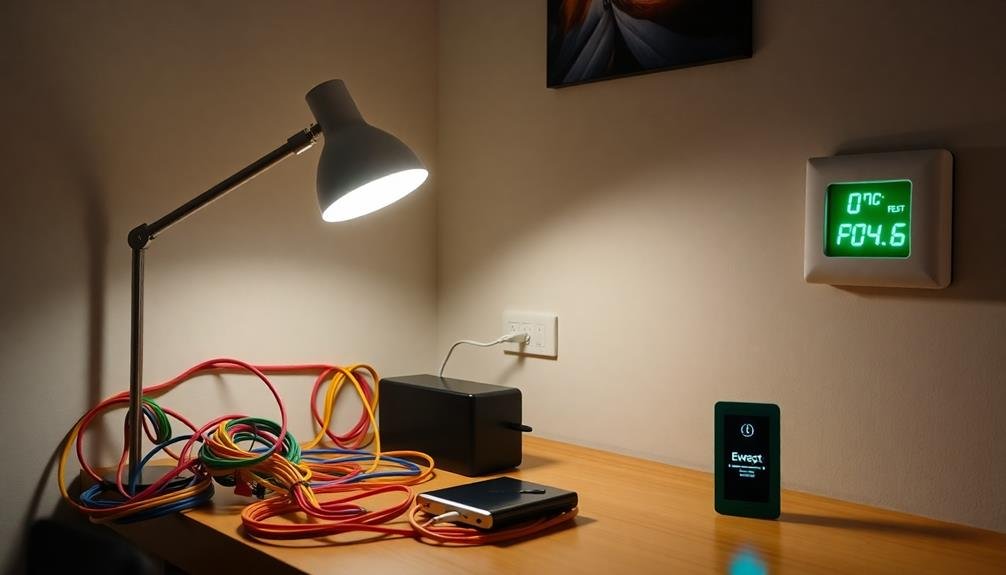
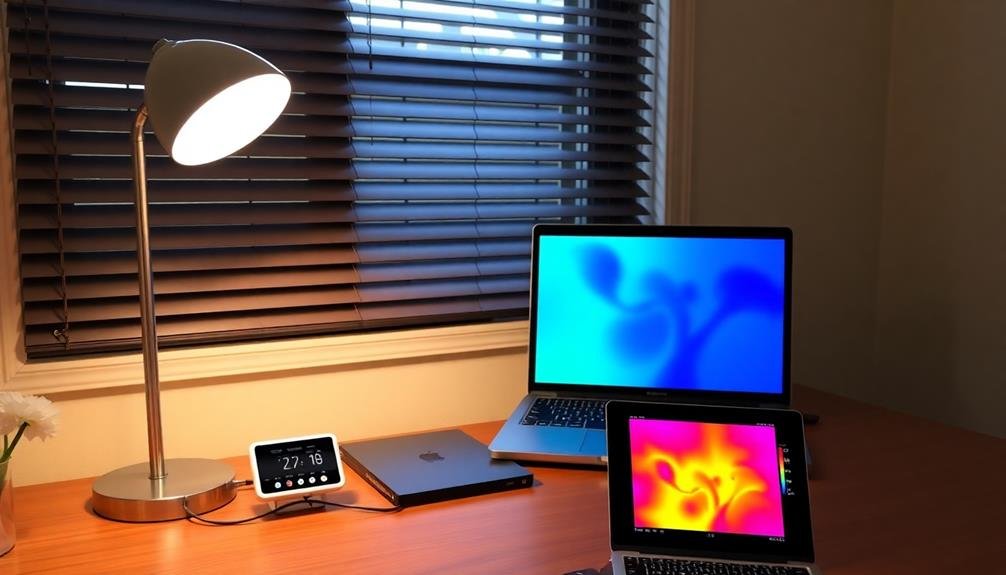
Leave a Reply